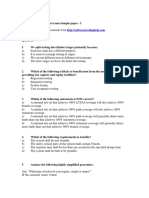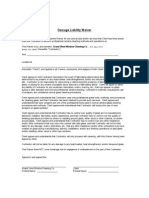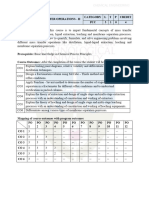Cs 2055 Software Quality Assurance
Cs 2055 Software Quality Assurance
Uploaded by
vanitharavichandranCopyright:
Available Formats
Cs 2055 Software Quality Assurance
Cs 2055 Software Quality Assurance
Uploaded by
vanitharavichandranCopyright
Available Formats
Share this document
Did you find this document useful?
Is this content inappropriate?
Copyright:
Available Formats
Cs 2055 Software Quality Assurance
Cs 2055 Software Quality Assurance
Uploaded by
vanitharavichandranCopyright:
Available Formats
CS 2055 SOFTWARE QUALITY ASSURANCE QUESTION BANK CS2055 Software Quality Assurance UNIT I PART - A 1. Define quality. 2.
. What is quality cost? 3. What are the building blocks of total quality management? 4. What are the 7 QC tools? 5. What is business process reengineering? 6. Define Quality Function Deployment. 7. Define six sigma. 8. What are the uses of arrow diagram? 9. What are the different dimensions of quality? 10. What is external failure? 11. What are the uses of control charts?. 12. Steps involved in the bench marking process. 13. What is statistical process control? 14. Define TQM. 15. What is quality planning? 16. What is quality improvement? 17. What is quality management? 18. What are the benefits of QFD? 19. What is internal benchmarking>? 20. What are the four ps focused on effective software project management? PART B 1. Explain Quality Function Deployment in detail. (16) 2. Describe in detail the standardization procedure of benchmarking. (16) 3. Explain how software quality assurance is ensured in a software firm. (16) 4. Explain the seven basic quality control tools in detail. (16) UNIT II PART - A 1. Define software configuration management. 2. What are the different measurable characteristics of an OO design? 3. What are CASE tools?
4. What are function-oriented metrics? 5. Define white box testing? 6. What are the steps implied by statistical quality assurance? 7. Define Verification and Validation. 8. What is RMM plan? 9. What are the qualities team leaders should posses? 10. What is an agile team? 11. What are the categories of activities connected with measurement process? 12. What are the measures of software quality? 13. What is metrics evaluation? 14. What is software quality assurance? 15. What is SQA group? 16. What are the activities associated with SQA group? 17. What are the different SCM features? 18. What are reactive risk strategies? 19. What are the characteristics of software risks? 20. What is software availability? PART B 1. Explain software project management in detail. (16) 2. Explain how software quality assurance is ensured in a software firm. (16) 3. What are the different software testing tactics? Explain. (16) 4. Write detail notes on risk management. (16) UNIT III PART - A 1. What are the management responsibilities regarding ISO 9001 requirements? 2. Define SPICE. 3. What is MALCOLM BALDRGE award? 4. What are the ISO 9000 series of quality management standards? 5. Define CMM. 6. What are the capability levels defined in SPICE? 7. What are the types of accreditation? 8. What are the components of the ISO 9000 series to which SPICE is related? 9. What is and assessment instrument? 10. What are the goals of SPICE project? 11. What are the benefits that an international standard will provide to industry? 12. What are the benefits of ISO 9000 verification? 13. What are the events associated with quality management? 14. What are the documents required to implement quality management system in an organization? 15. What are the pre-requisites for employees?
16. What are the requirement of internal auditing? 17. What are the different organizations to which the Malcolm Balridge award is given? 18. What are the different process maturity levels? 19. Who are the steps organizations has to take to improve their software capabilities?? 20. What are the requirements of ISO 9001: 2000 standard? PART B 1. Write detail notes on ISO9000 series of quality management standards. (16) 2. Account on CMM in detail. (16) 3. Give a detail note on SPICE in detail. (16) 4. Write detailed notes on Malcolm Baldrige award. (16) 3 UNIT IV PART - A 1. What are the different principles of software assessment? 2. Who are the different inspection participants? 3. Define software engineering process.
4. Define software process architecture. 5. Define software process model. 6. Define software process. 7. What are the critical software process issues? 8.What are the different process model views? 9. What are the drawbacks of water fall model? 10. What are the different levels of software process models? 11. What are the different types of software tests? 12. Define testing. 13. Define debugging. 14. What are integration tests. 15. What are regression tests? 16. What are installation tests? 17. What are the major test plan elements? 18. What should be the qualities of assessment team members? 19. What are the different risks associated with a software process? 20. What are the basic objectives of inspections? PART B 1. Explain how software process assessment helps software organizations to
improve themselves. (16) 2. Explain the testing phase of software development in detail. (16) 3. Give detailed description about software process assessment. (16) UNIT V PART - A 1. Why defect prevention is crucial to the software process? 2. What are the principles of software defect prevention? 3. What are the different steps of software defect prevention? 4. What are the different errors for which defect prevention analysis is required? 5. What are the different ways in which CMMI represents a process meta model? 6. What is PSP? 7. What are the different framework activities defined by PSP model? 8. What is postmortem in PSP? 9. What are the objectives of TSP? 10. What are the framework activities defined by TSP? 11. What are the different box used in clean room software engineering? 12. What is cleanroom software engineering? 13. What is state box? 14. What are the different models require for cleanroom software engineering certification? 15. What is object oriented systems development methodology? 16. What are the reasons for the necessity of object orientation? 17. What is UML? 18. What are the different diagrams defined in UML? 19. What is classification? PART B 1. Explain software inspections in detail. (16) 2. Explain OO methodology in detail. (16) 3. Write detailed notes on the techniques for error cause analysis and defect prevention. (16) 4. Account on clean-room software engineering. (16) 5. Write notes on TSP and PSP. (16)
You might also like
- Buckwold 20ce sm04Document68 pagesBuckwold 20ce sm04Kailash Kumar100% (1)
- Company Profile DCTCDocument14 pagesCompany Profile DCTCvalerie05No ratings yet
- SQM 16 & 2marks With AnsDocument21 pagesSQM 16 & 2marks With AnsKalyan SundaramNo ratings yet
- Software Quality Assurance Question BankDocument4 pagesSoftware Quality Assurance Question Banksridharanc23No ratings yet
- Jaipuria Institute of Management Lucknow: "Comparative Analysis of CRM Practices in Bakery Industry"Document31 pagesJaipuria Institute of Management Lucknow: "Comparative Analysis of CRM Practices in Bakery Industry"Smita Singh100% (2)
- Chap 8Document10 pagesChap 8Tú B Mai100% (1)
- SPPM Important QuestionsDocument1 pageSPPM Important Questionssai teja100% (1)
- SPPM BitsDocument2 pagesSPPM Bitsramesh kumarNo ratings yet
- SPM PPT U1Document29 pagesSPM PPT U1Venkata Nikhil Chakravarthy KorrapatiNo ratings yet
- STQA Imp QuesDocument3 pagesSTQA Imp QuesAnubhav SinghNo ratings yet
- Testing DocumentDocument22 pagesTesting DocumentManohar G Shankar100% (1)
- SQM NotesDocument88 pagesSQM NotessoniiimoniiikaluNo ratings yet
- Project Organizations and Responsibilities:: 1) Line-Of-Business OrganizationsDocument9 pagesProject Organizations and Responsibilities:: 1) Line-Of-Business Organizationsdd ppNo ratings yet
- SE CH - 3 Software Requirement EngineeringDocument4 pagesSE CH - 3 Software Requirement EngineeringsahilNo ratings yet
- L04-The Components of Software Quality Assurance SystemDocument47 pagesL04-The Components of Software Quality Assurance SystemLee StevenNo ratings yet
- Software Quality and TestingDocument36 pagesSoftware Quality and TestingakiraNo ratings yet
- Chapter 2 - Requirements Engineering ProcessDocument57 pagesChapter 2 - Requirements Engineering Processgedamulatu6No ratings yet
- Book Answer Summaries Chapter 2 3Document6 pagesBook Answer Summaries Chapter 2 3ghada alshabibNo ratings yet
- BSC It 6TH SemDocument19 pagesBSC It 6TH SemAbid AliNo ratings yet
- 06 Static TestingDocument17 pages06 Static TestingNaro Venna VeledroNo ratings yet
- It8075 SPM Unit II NotesDocument18 pagesIt8075 SPM Unit II NotesLionel Bharath RazerNo ratings yet
- Unit - Iv Software Quality Planning & ControlDocument11 pagesUnit - Iv Software Quality Planning & ControlPulkit JainNo ratings yet
- SPPM Imp QuestionsDocument1 pageSPPM Imp QuestionsAbhi ShekNo ratings yet
- ISTQB Foundation Sample Question Paper No. 27: Download More Sample Papers atDocument6 pagesISTQB Foundation Sample Question Paper No. 27: Download More Sample Papers atEdin KeviljNo ratings yet
- Ch-2-Maintenance Support Processes1Document59 pagesCh-2-Maintenance Support Processes1Eden SibhatNo ratings yet
- NASA Software Assurance TrainingDocument65 pagesNASA Software Assurance TrainingSabahat Hussain100% (1)
- AD 03. Requirements DeterminationDocument41 pagesAD 03. Requirements DeterminationAhmad SentanuNo ratings yet
- Stqa MCQ 1Document16 pagesStqa MCQ 1Ashvini Avinash BamanikarNo ratings yet
- Software Testing Quiz Questions and Answers: Show AnswerDocument14 pagesSoftware Testing Quiz Questions and Answers: Show AnswersayedmahgoubNo ratings yet
- Rajib Mall Lecture NotesDocument69 pagesRajib Mall Lecture NotesAnuj Nagpal0% (1)
- SQM NotesDocument164 pagesSQM NotesASGNo ratings yet
- STM Unit3 DFGDocument51 pagesSTM Unit3 DFGrkrajdevloper34No ratings yet
- Different Software Quality ModelDocument5 pagesDifferent Software Quality ModelEditor IJRITCCNo ratings yet
- DO Qualification Kit: Plan For Software Aspects of Certification (PSAC)Document65 pagesDO Qualification Kit: Plan For Software Aspects of Certification (PSAC)Ícaro VianaNo ratings yet
- CocomoDocument47 pagesCocomoAbdulhaq SadiqiNo ratings yet
- Software Quality EnginneringDocument26 pagesSoftware Quality EnginneringVinay PrakashNo ratings yet
- Rajib Mall Lecture Notes Part 22Document56 pagesRajib Mall Lecture Notes Part 22Anuj NagpalNo ratings yet
- Software Quality MetricsDocument46 pagesSoftware Quality MetricssakshiNo ratings yet
- SPPMDocument246 pagesSPPMBhure VedikaNo ratings yet
- 1.1 Introduction To Software EngineeringDocument25 pages1.1 Introduction To Software EngineeringArrahim FitrahNo ratings yet
- STQA 2015 16 AprilDocument2 pagesSTQA 2015 16 AprilSwapnil ShindeNo ratings yet
- Defect Classification and AnalysisDocument30 pagesDefect Classification and AnalysisshingkeongNo ratings yet
- ISTQB Sample Question Paper - 5: SystemDocument6 pagesISTQB Sample Question Paper - 5: SystemSAnuradhaNo ratings yet
- Unit 3 Estimation and Scheduling PDFDocument46 pagesUnit 3 Estimation and Scheduling PDFPrasad PatilNo ratings yet
- Software Engineering SYIT SEM-IVDocument7 pagesSoftware Engineering SYIT SEM-IVRohan GhadgeNo ratings yet
- Data Structures Through C++: Lab ManualDocument26 pagesData Structures Through C++: Lab Manualahmadhassan306No ratings yet
- Requirement EngineeringDocument17 pagesRequirement Engineeringhitendra chaudhariNo ratings yet
- Unit - 4: Testing and MaintenanceDocument39 pagesUnit - 4: Testing and Maintenancesathyaaaaa10% (1)
- Lesson15 Coverage and MCDCtestingDocument47 pagesLesson15 Coverage and MCDCtestingArunkumarcareerNo ratings yet
- 8.2 - Software Quality Assurance - RevisedDocument28 pages8.2 - Software Quality Assurance - Revisedkaosar alamNo ratings yet
- Istqb Exam Sample Paper 1-3Document25 pagesIstqb Exam Sample Paper 1-3JaatfftNo ratings yet
- It8075 SPM Nov Dec 2020Document2 pagesIt8075 SPM Nov Dec 2020Dr.R.MurugadossNo ratings yet
- STA 2 MarksDocument20 pagesSTA 2 MarksVIMAL KUMAR DNo ratings yet
- Software Testing and Quality AssuranceDocument13 pagesSoftware Testing and Quality AssuranceUmesh PatilNo ratings yet
- SPPM Unit - 1 NotesDocument28 pagesSPPM Unit - 1 NotesUchiha Sasuke100% (1)
- Software Testing - MCQDocument7 pagesSoftware Testing - MCQNishaPaulineNo ratings yet
- Software Project ManagmentDocument3 pagesSoftware Project ManagmentMani DkmNo ratings yet
- Final Exam 2nd Semester Data Mining 2nd VersionDocument1 pageFinal Exam 2nd Semester Data Mining 2nd VersionghostNo ratings yet
- Software ProcessDocument25 pagesSoftware ProcessHarsha VardhanNo ratings yet
- Object Oriented System MethodologyDocument49 pagesObject Oriented System MethodologySagar NNo ratings yet
- Software Project ManagementDocument20 pagesSoftware Project Managementbvcoehodit navi mumbaiNo ratings yet
- Cs 2055 Software Quality AssuranceDocument3 pagesCs 2055 Software Quality AssuranceAnand KannanNo ratings yet
- Software Quality Assurance QB PDFDocument4 pagesSoftware Quality Assurance QB PDFnagarajan888No ratings yet
- People CodeDocument44 pagesPeople CodehardanuNo ratings yet
- Chittagong Stock ExchangeDocument3 pagesChittagong Stock ExchangeTowsif Noor Jamee100% (1)
- H 4071 8504 04 A - Omp40 2 - (Ig) - enDocument48 pagesH 4071 8504 04 A - Omp40 2 - (Ig) - enRory CollinsNo ratings yet
- Heat Transfer Enhancement in Heat Recovery Steam Generator Using Dry Ice Co Blasting Cleaning MethodDocument2 pagesHeat Transfer Enhancement in Heat Recovery Steam Generator Using Dry Ice Co Blasting Cleaning MethodDimas PalgunadiNo ratings yet
- Zara Case Study HarwardDocument7 pagesZara Case Study HarwardNeetika Ghai ManglaniNo ratings yet
- CBLM Washing Machine, (Revised)Document51 pagesCBLM Washing Machine, (Revised)sorcererpcNo ratings yet
- World EconomyDocument21 pagesWorld EconomyRaluca CristeaNo ratings yet
- XPath PDFDocument3 pagesXPath PDFBhushanNo ratings yet
- Aiface - Mars: Linux-Based Access Control and Time & Attendance Terminal With Visible Light Facial RecognitionDocument2 pagesAiface - Mars: Linux-Based Access Control and Time & Attendance Terminal With Visible Light Facial RecognitionSaptarshi GanguliNo ratings yet
- LVK VLG en V1Document2 pagesLVK VLG en V1Даниил СторчеусNo ratings yet
- Unable To Issue SVM Commands in Single User ModeDocument2 pagesUnable To Issue SVM Commands in Single User ModecresmakNo ratings yet
- Damage Liability WaiverDocument1 pageDamage Liability WaiveritargetingNo ratings yet
- Dos DontsDocument1 pageDos DontsJoel BrasilBorgesNo ratings yet
- Iso 6743-3Document8 pagesIso 6743-3viktor_gligorov100% (1)
- Pynvme: An Open, Fast and Extensible Nvme SSD Test Tool: Crane Chu, Engineer, Founder Geng Yun Technology Pte LTDDocument28 pagesPynvme: An Open, Fast and Extensible Nvme SSD Test Tool: Crane Chu, Engineer, Founder Geng Yun Technology Pte LTDNitesh GargNo ratings yet
- CHT302 - Ktu QbankDocument8 pagesCHT302 - Ktu Qbanknaagin12300No ratings yet
- Ilaw at Buklod NG Manggagawa (IBM), vs. NLRC, G.R. No. 91980, June 27, 1991Document16 pagesIlaw at Buklod NG Manggagawa (IBM), vs. NLRC, G.R. No. 91980, June 27, 1991rafaelturtle_ninjaNo ratings yet
- Exercises Matura - AllunitsDocument30 pagesExercises Matura - AllunitsRenata FiderkiewiczNo ratings yet
- NIkhil CV - Planning Consultant-HoneywellDocument3 pagesNIkhil CV - Planning Consultant-Honeywelljillan ksrNo ratings yet
- 465 Course OutlineDocument3 pages465 Course OutlineSamiul21No ratings yet
- 2012-06 Safety Beacon - Nitrogen HazardsDocument1 page2012-06 Safety Beacon - Nitrogen Hazardsأحمد موريسNo ratings yet
- B1 Vocab All NicoDocument11 pagesB1 Vocab All NicoRaj pNo ratings yet
- Introduction Meraki Cisco & Demo Lab 25042022Document12 pagesIntroduction Meraki Cisco & Demo Lab 25042022Rinda Naomi KosasihNo ratings yet
- RAJ Seminar PaperDocument16 pagesRAJ Seminar PaperMohammed RaihanNo ratings yet
- Bangladesh Taxation Overview 2Document7 pagesBangladesh Taxation Overview 2Reznov KovacicNo ratings yet
- Material PropertiesDocument2 pagesMaterial PropertiesCelineKevinNo ratings yet
- Testing Advance TechniquesDocument154 pagesTesting Advance TechniquestuviejaNo ratings yet

























































































